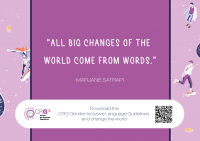 NOTICIAS
NOTICIAS
New CRG Gender-Inclusive Language Guidelines published
The guidelines mark the CRG’s commitment for the use of gender-inclusive language in its written and spoken communications.
The Centre for Genomic Regulation (CRG) is firmly committed to create a fairer, more tolerant and egalitarian society of women and men. We believe that respecting fundamental rights are key to the advancement and development of equality. We made this commitment in the CRG’s Equality, Diversity and Inclusion Plan 2020-2023.
One of the strategic aims of this plan revolves communication and language, including reflecting on the use of gender in language. With this in mind, the CRG produced the Gender-Inclusive Language Guidelines, which provide practical advice in English, Spanish and Catalan on the use of gender-fair and inclusive language.
The guidelines mark the CRG’s commitment for the use of gender-inclusive language in its written and spoken communications. We welcome the whole CRG community to make their own contributions by raising awareness of these guidelines and the importance of their use in all our publications and communications.
Using gender-inclusive language means speaking and writing in a way that does not discriminate against a particular sex, social gender or gender identity, and does not perpetuate gender stereotypes. Given the key role of language in shaping cultural and social attitudes, using gender-inclusive language is a powerful way to promote gender equality and eradicate gender bias.
The resources provided in these guidelines are aimed at helping the CRG staff to communicate in a non-sexist and gender-inclusive way in English, Spanish and Catalan, and include a number of recommendations to help the CRG staff to use gender-inclusive language in any type of communication — oral or written, formal or informal, or addressed to an internal or external audience.
The purpose of these guidelines is not to constrain authors in the CRG to follow a mandatory set of rules but rather encourage our staff to give due consideration to the issue of gender sensitivity in language whenever they communicate.
Related materials:

